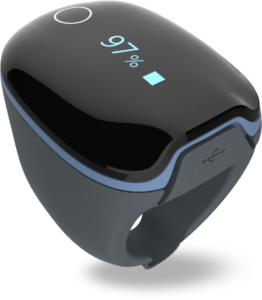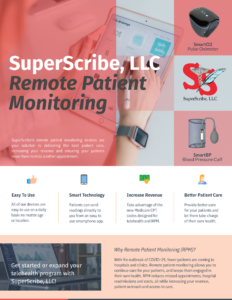As we continue to learn more about COVID-19 and its affect on the human body, there are some recurring terms that keep popping up. Pulse oximetry continues to be tossed around, but using it is nothing new to the medical field. Pulse oximetry is the measure of the saturation of oxygen in your blood. The term associated with pulse oximetry is SpO2.
The SmartO2 is SuperScribe’s pulse oximeter, or device to measure SpO2 for you. Traditionally, pulse oximeters are worn on the fingertip where they will either perform a spot check (once) or continuously monitor your blood oxygen level. The continuous monitoring style can be cumbersome and is generally done in the hospital where it is part of a machine that takes other body measurements such as blood pressure, heart rate, ECG, etc. The SmartO2 is innovative due to its ring style that brings continuous monitoring home without all the wires and machines. It’s also noninvasive, which means that nothing goes inside of your body. Pulse oximeters operate by using an infrared light from one side and goes through your finger to another sensor directly opposite of the light emitting sensor. This is completely safe and won’t cause any harm to you. By utilizing Bluetooth technology, the SmartO2 is able to safely and directly connect to your phone or tablet. And results can be emailed to your provider, or uploaded into your EHR via Apple Health, your data remains HIPAA compliant.
The SmartO2 is a ring style, so it can be comfortably worn during the day or overnight. This allows you to monitor your blood oxygen levels over a period of time, which is important because blood oxygen saturation can give you variable readings depending on when, what you’re doing, etc. The SmartO2 has a heart rate monitor and motion monitor, so you can see more of your vitals, especially during resting periods or during sleep. Sleep apnea patients can take advantage of this to see if they are getting enough oxygen while they sleep.
So how else does it help providers? There a few specialities that benefit from understanding pulse oximetry and having that data on hand. Nephrology, pulmonology, cardiology, and oncology can greatly benefit from knowing the SpO2 of their patients. Pertaining to COVID-19, pulse oximetry measurements is invaluable to monitoring patients outside of the hospital. Breathlessness and shortness of breath are common with COVID-19, but hypoxia is also a major concern because a patient could have low blood oxygen levels without feeling the symptoms of shortness of breath. With hospitals reaching maximum bed capacity, letting patients keep track of their health at home saves bed space for non-COVID patients, reduces PPE costs, and lessens travel time/expenses.
View our


